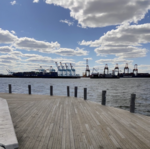Port Newark–Elizabeth Marine Terminal
Container terminalsEconomy of Newark, New JerseyElizabeth, New JerseyGeography of Newark, New JerseyPort Authority of New York and New Jersey ... and 4 more
Port of New York and New JerseyPorts and harbors of New JerseyTransportation buildings and structures in Essex County, New JerseyTransportation in Newark, New Jersey

Port Newark–Elizabeth Marine Terminal, a major component of the Port of New York and New Jersey, is the principal container ship facility for goods entering and leaving New York metropolitan area and the northeastern quadrant of North America. Located on Newark Bay, the facility is run by the Port Authority of New York and New Jersey. Its two components—Port Newark and the Elizabeth Marine Terminal (sometimes called "Port Newark" and "Port Elizabeth")—sit side by side within the cities of Newark and Elizabeth, New Jersey, just east of the New Jersey Turnpike and Newark Liberty International Airport.
Excerpt from the Wikipedia article Port Newark–Elizabeth Marine Terminal (License: CC BY-SA 3.0, Authors, Images).Port Newark–Elizabeth Marine Terminal
Newark
Geographical coordinates (GPS) Address Nearby Places Show on map
Geographical coordinates (GPS)
| Latitude | Longitude |
|---|---|
| N 40.68155 ° | E -74.1505 ° |
Address
Newark
Newark
New Jersey, United States
Open on Google Maps










